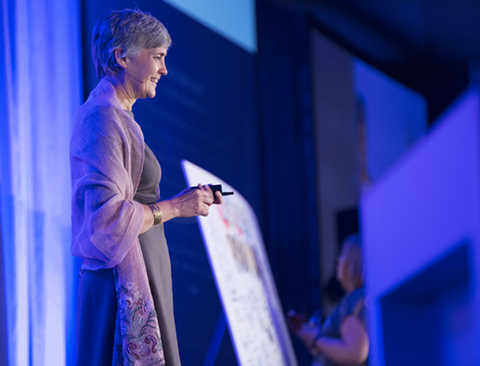Ray Kurzweil envisions a future that on the surface doesn’t look pretty.
By the year 2020, 3D printing will have utterly transformed manufacturing. For example, people will be printing out their own clothing, he predicts. The reaction will be, “Oh great, there goes the fashion industry.”
In Asia, builders are already making small office buildings using modules made by 3D printers.
Incredibly, inventors have already created jet engines and cars out of printed parts, Kurzweil says.
The impact on an already decimated manufacturing industry could be catastrophic. Even more jobs will be lost and manufacturing will be turned into an information-technology industry, he suggests.
But there is a silver lining behind this industry disruption, he says.
The fashion industry will explode with new ideas as more people design, make and share their own clothes using 3D printers.
Kurzweil foresees a similar impact on other manufacturing businesses as they move into an open-source design and production environment.
Kurzweil is not just some crazy fortune-teller who gazes into a crystal ball and makes wild predictions. The 68-year-old New Yorker is considered one of the world’s leading thinkers, inventors and futurists. He has penned five best-selling books on artificial intelligence and other technology trends and is heading up a team at Google studying machine intelligence and natural-language understanding. The Wall Street Journal has called him “the restless genius.”
As a child, he started bringing home old bicycles and radios to fix in an era when five-year-olds “could still rummage through neighbourhoods.” At 14, he wrote a research paper on how the brain worked. It earned him an audience with then-president Lyndon Johnson.
Kurzweil was one of two keynote speakers at Communitech’s annual Tech Leadership Conference held Thursday at Bingemans in Kitchener. More than 800 people attended the one-day show, which featured presentations by close to a dozen speakers on topics such as robot ethics, marketing for tomorrow, artificial intelligence and building a brain.
Manufacturing won’t be the only industry to undergo massive change in the coming years. Technology will also revolutionize human health and biotechnology, he predicts.
Stem cells can be programmed to rejuvenate heart-attack victims, genes can be manufactured and injected into the body to reduce pulmonary hypertension and tiny nano robots can be inserted into the brain to extend our thinking power.
These nano robots will be connected to computers in the cloud so we can access vast amounts of data in seconds. They will make us funnier, sexier and more creative, he predicts.

Zipcar founder Robin Chase delivers an impassioned speech highlighting
the sharing economy, and the need for humans to collaborate to solve
big problems like climate change. (Communitech photo: Meghan Thompson)
The second keynote speaker was Robin Chase, the founder and former chief executive of Zipcar, the world’s largest car-sharing company, and an expert on innovation and the sharing economy.
Chase said the shared or collaborative economy offers the best solution to the growing threat of climate change. Shared assets and minds generate ideas in a more efficient and abundant fashion than traditional companies, which operate in closed environments, said the Boston-based entrepreneur.
Zipcar was created to “leverage the excess capacity” of the automobile, she says. The car is the second-most expensive purchase most people make, yet they use it only five per cent of the day. Car-sharing works because it is based on participation and treating customers as members and collaborators, Chase says.
The chances are greater that the right person with the right idea will appear in a collaborative economy than one based on a closed system, she says.
But the two systems can use each other’s strengths to come up with solutions to global problems, she says. Individuals bring creativity, local knowledge and the ability to customize to the table, while companies offer large investments, manufacturing capacity and growth-management. She calls this “Peers Inc.,” the peers standing for individuals and the Inc. for large companies.
Apart from the two keynote sessions, participants broke into smaller groups for learning sessions.
Kate Darling, a researcher at the Massachusetts Institute of Technology and an expert on the interaction of people and machines, spoke on the topic of robot ethics.
For many people, robots have a negative image. They’re going to steal our jobs, spy on us on the form of drones and even kill us, a scenario popularized in Hollywood movies, Darling says.
But the reality is that robots have many positive uses. Cute-looking robots can make autistic children more responsive and act as companions for seniors, she says. In some cases, people have learned languages or lost weight more quickly working with robots rather than humans, she says.
In Japan, robots in factories are given names and even do gymnastics with workers to make them more acceptable.
“You have to weigh the positive (about robots) against the creepiness factor.”
In a presentation on virtual and augmented reality, Jesse Hirsh, a Toronto-based technology strategist, said these types of activities hold loads of potential for transforming the architectural and construction industries. By simulating a 3D reality, architects can design buildings more easily and creatively and individuals can even design their own cottages, Hirsh says.
By recreating battlefields and how troops move within them, virtual reality can also transform military conflicts, he says. Other uses include enabling people to switch genders to engender empathy for the opposite sex.
Adam Green, who runs advertising agency relations for Google Canada, spoke on the topic of marketing for tomorrow. Customers make purchases based on their future, not on the features of your product, he says.
He cited a recent iPhone ad that showed users taking beautiful pictures of boats on the Yangtze River in China. The ad never mentioned the specs, materials or megapixels in the camera.
When people buy a car, they don’t do it by poring over a spreadsheet about the size of the engine, the make of the wheels or the technology in the brakes, Green says. They base their purchase on their emotional response to the vehicle.
Mark Roberge, chief revenue officer at HubSpot, a Massachusetts company that makes software for inbound marketing, said the massive loss of jobs in the media can be turned into an advantage in the marketing field. Journalists can tell a company’s story or describe its product in a more compelling way than ordinary sales people, he said.
Surround a journalist with a company’s thought-leaders and they can produce blogs and short e-books that draw customers in, Roberge noted.

The Tech Showcase was a highlight during TLC 2016.
(Communitech photo: Meghan Thompson)
In a presentation on artificial intelligence, Nikolas Badminton said machine-learning systems can spot skin cancer in photos of seniors or work one-on-one with children in schools. They can also make cities run more efficiently by improving traffic flows and operating traffic lights.
Fridges can be programmed to lock their doors and tell you when to exercise, says Badminton, who studies how technology is affecting the workplace. But it might be difficult to change them when you get home at 3 a.m. and want a beer and pizza, he says.
Chris Eliasmith, director of the Centre for Theoretical Neuroscience at the University of Waterloo, conducted a learning session on building a brain. His lab has built the world’s largest functional brain model, called Spaun.
In addition to solving brain disorders, the model can help scientists and engineers build smarter machines, he says. They can do this by designing computer chips that function more like a brain.
In a fireside chat with education futurist Sarah Prevette, former Open Text CEO Tom Jenkins outlined three emerging trends in the tech industry.
The first, digital disruption, has already had a major impact on manufacturing. Now it is poised to disrupt white-collar sectors such as financial services and banking, he says. Job losses are expected to reach 30 per cent over the next five years, says Jenkins, now chair of the Open Text board and chancellor of UW.
The second-trend, data sovereignty, threatens to shake up the information sector, he says. The location of servers will become more important if countries and regions form trading blocs and restrict access.
The third trend, regulatory frameworks, is also undergoing change, Jenkins says. Regulatory platforms need to become principal-based rather than rules-based to adapt to changing environments.
Regulatory bodies are “boring, but they have a big impact,” he says. Ever tried to get something approved by the Food and Drug Administration in the U.S.? It takes about a decade, Jenkins says.

